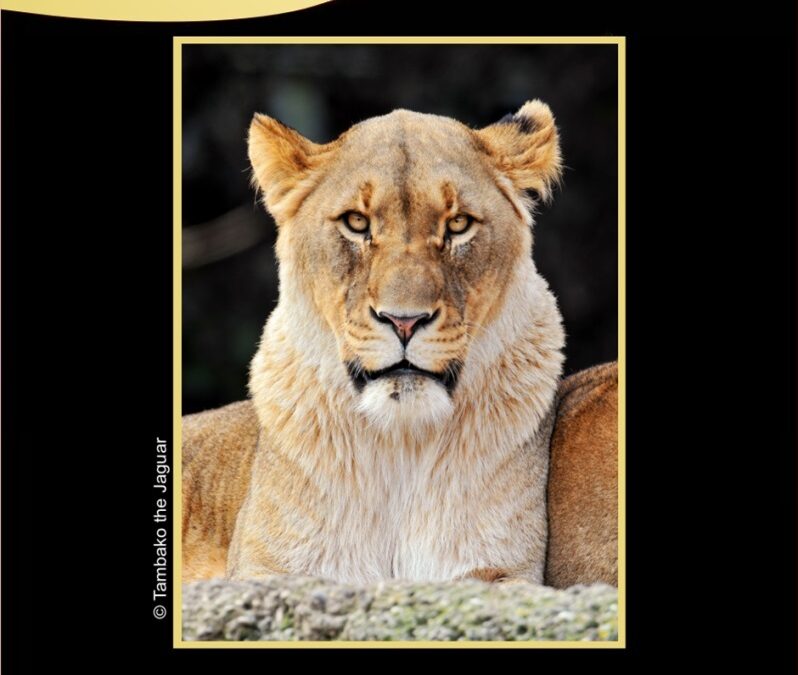Note to readers: Biological Expositions is a series of blog-posts each of which is equivalent in content to a book chapter. If bio-bullets are likened to a starter, blog-posts could be seen as a light lunch and Biological Expositions as a three course meal. We look forward to your comments on this series.
The lioness may show off in more ways than meets an infatuated eye.
The lion has been studied so keenly by zoologists that it may seem that there’s little left to discover. And this revered animal could hardly be more familiar to the public. However, some of the most obvious aspects of the lion may have remained just beyond the Bio-edge. For looking may not be seeing where our gaze is overloaded with expectation.
When tourist vehicles shutter around a group of slumbering lions in a small cloud of flies, a Martian might wonder what could be so photogenic. But what the visitors are trying to snap is not brownish forms dozing under a tree as much as various layers of meaning. People are thrilled not as much by what is self-evident as by what is subconsciously uploaded into this scene according to heraldry, mythology, history, symbolism and hyperbole.
Although this fearful beauty lies in the eye of the beholder, in the lion there’s both less and more than meets the eye. Large felids are so coloured by investments of imagination that aspects of their real appearance may hide in plain sight.


Figure 1. Female lion, one of the most plain-coloured, counter-shaded, and inconspicuous of felids – or is she? [photo © C. Puchades].
By scrutinising the coat of the lion we’ve spotted several flags that don’t seem to have been written about before – even by scientists specialising in the study of this species. We share these here in the interests of a deeper biological understanding of a popular animal. Let us point out how several subtle aspects of colouration may reveal the sexual and social life of this species compared with its less lionised relatives.
There are five features on the body of the lion which may flag its presence to members of the same species; we’ll call these the mouth flag, chest flag, tail flag, neck flag and back-of-ear flag.
But first, let’s consider the background. Readers may understand that a plain colouration allows a large felid to blend into open grassland by day and night – and that the male lion relaxes this crypsis to some extent to advertise his sexual prowess. And it’s true that, at first glance, the lion is remarkably plain-coloured, except for a potentially dark mane. Indeed, the body’s pale ventral surface seems to merely mute the shading of the body in sunlight. And the well-known principle of counter-shading seems to help the lion – like so many other dull-coloured animals – to flatten into a dull background (see Figure 1).
However, we’ve chosen photos in this blog-post to show that aspects of the colouration of even the female lion are contrary to counter-shading. Various flags, although conspicuous enough to compromise its crypsis to some degree, may be socially valuable to this most gregarious of felids. Let’s consider each flag in turn.
The mouth flag is consistently present in the relaxed face of all adult lions, and obvious enough once recognised – although we’ve never read of it in any scientific or semi-popular article. See Figure 2 for a good example of the paleness of the fur on the ‘chin’ and upper lip. This mouth flag is usually presented in the female in conjunction with a larger but less intense, cream-coloured area on the throat and chest. Figures 2 and 4 show this chest flag on the female. Although the female lion blends into the grass when crouched, her mouth and, to a lesser degree, chest shine like a dimmed headlight once she sits up. In our experience, this glow can be obvious tens of metres away in daylight.

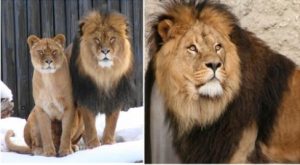
Figure 2. Female and mature male lion, showing mouth flag, consisting of pale ‘chin’ and upper lip, and chest flag, which is short-haired and pale in the female and maned, and dark in the mature male [photos © P. Longshore (left) and Felinest under Creative Commons licence 2.0 (right)].
Next is the tail flag, evident in Figure 3. It’s no surprise that the dark tassel of the tail can be a conspicuous point on the lion. However, in the female there’s also a small whitish strip of short fur of the ventral surface just short of the tassel. So when she lifts and curls her tail, what gleams is a contrast between the dark tassel and the sub-terminal sheen. Given that a raised tail attracts attention through its movement, the female lion emphasises this by highlighting the tail tip with a combination of long, dark and short, pale fur. This probably serves social purposes such as co-abandoning an attempted stalk, although felids also flick the tail in agitation when threatened by other species.


Figure 3. Female lion, showing tail flag [photos © D. Bygott (top) and R. Toller under Creative Commons licence 2.0 (bottom)].
The fourth and most subtle flag is the neck flag. Although the nape of the female lion is no paler than her body, a panel of silvery fawn is noticeable on each side of her neck between her ear and her shoulder. This pale flag – shown in Figure 4 – is faint and variable to a human observer and most easily observed at medium distance from the side and slightly behind the female lion. During a stalk it would be hidden from the prey but evident to co-stalkers. We speculate that the neck flag may be conspicuous enough in the eyes of the lion that it helps group members to monitor each other even at night.


Figure 4. Female lion, showing chest flag and neck flag [photo © T. Ryburn].
Finally, the back-of-ear flag is perhaps the most obvious of the five flags on the female lion by daylight. However, it’s best appreciated in contrast to the front of the ears which, like the back of the neck, are nondescript fawn. The posterior surface of the ear of the lion, unlike the anterior surface, displays a bold diagonal bar. This appears most starkly when the lion has pricked ears and faces away from the observer, an aspect in which – as evident in the top of Figure 5 – the dark bar is offset against the pale of the neck flag. However, the back-of-ear flag can also appear in full-frontal confrontation, when the ears are folded appropriately (see the bottom of Figure 5).
Although the back-of-ear flag has been mentioned by other authors, it has yet to be explained satisfactorily. It’s easy to assume that this flag signals to juveniles following their mother. But then why is it already present in the infants themselves, at an age when there is still faint spotting on the body, and why does it persist even in the maned male, on which it seems superfluous? We infer that back-of-ear patterns may be a versatile means for intraspecific communication in various felids. Close up, these patterns emphasise certain postures of the ears and help to express certain emotions in social interactions. At medium distance, in the case of the lion, they are likely to constitute a flag that helps stalking females to keep track of each other in crouched postures.
The pale flags on the lion seem clearer at medium-range than close-up, leading us to speculate that the whitish, cream-coloured or silvery fawn hairs don’t just lack pigment but possess some kind of unstudied sheen. We suspect that the pale fur of all five flags shine with ultraviolet light. What we’re suggesting is that the hairs have physical and chemical properties that produce sheen in the visible spectrum while at the same time reflecting in ultraviolet, and that this makes the flags conspicuous to the lion by both day and night.

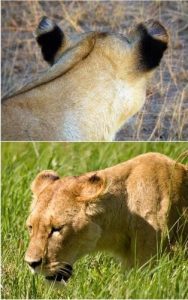
Figure 5. Female lion, showing back-of-ear flag [photos © D. Bygott (top) and W. Warby under Creative Commons licence 2.0 (bottom)].
It’s not far-fetched to suggest that the lion sees ultraviolet because many partly nocturnal mammals including deer and mice can do so. The human inability to see ultraviolet isn’t because our retina is incapable of seeing the shortest wavelengths of the visible spectrum. Instead it’s because we’re among the most diurnal of animals and our cornea and lens are designed to filter out ultraviolet, protecting our retina from sunburn.
So far we’ve focussed mainly on the female. Now let’s re-examine the mature male lion – with a particular eye for shine and sheen. We will look well beyond his obvious mane, which provides a dark counterpart for the chest flag of the female.
It’s easy to assume that a mane makes the male more conspicuous than the female, but this may not be true in all lighting conditions. A dark mane isn’t necessarily more striking than the pale chest of a female sitting upright. Similarly, when viewed obliquely from behind, a dark mane on the sides of the neck isn’t necessarily more conspicuous – particularly at night – than the pale neck flag of the female. And although the mouth flag is equally well-developed in the female and the male, the tail flag seems poorly developed in the male. This is because the male’s tail has the dark tassel but not the noticeably pale surface subtending it. The back-of-ear flag is present in both sexes and all ages of the lion, and although it may appear insignificant against the mane, it’s noteworthy that – unlike other maned mammals such as certain baboons – the ears are not hidden in the mane but instead protrude from it.
What all of this suggests is that in the eyes of members of the same species, the mature male lion may not be more conspicuous than the female after all, particularly at night. The flags he does retain in full form are the frontal, and confrontational, ones: his whitish mouth underscored by the dark mane on his chest.
Readers, please bear in mind that our list of five flags may not be complete for the lion as a species. This is because much of the geographic variation in colouration may have been lost to science forever. The lion existed prehistorically as far as the Americas in the form of different subspecies. Cave art shows no mane on the lion in Europe and Alaska in the last Ice Age. So, possibly the colouration also differed in ways appropriate to an environment far removed from the brightly-lit tropical savanna.
Bearing in mind that members of the cat family may share similar patterns for phylogenetic reasons, are we perhaps reading too much into the colouration? Let’s compare the flags of the lion with those of related species around the world, to see how and why the lion differs from other large felids.
Of all large cats, the cheetah is perhaps most similar to the lion in possessing a mouth flag. The difference between the two is that in the small-mouthed species most of the pale area is actually the immaculate throat (see Figure 6). The puma also has a mouth flag, but its face is even more vivid than the lion because its whitish ‘upper lip’ is framed in dark brackets, an accentuation that may be superfluous in the lion with its larger size. In contrast to the lion, we find that the tiger, jaguar, leopard and snow leopard all lack the mouth flag because small spots and stripes extend on to the ‘chin’ and upper lip in these species, thereby camouflaging the face.
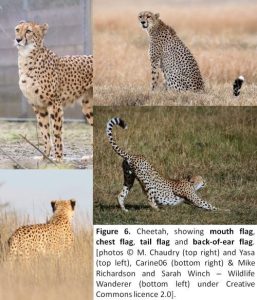
Figure 6. Cheetah, showing mouth flag, chest flag, tail flag, andback-of-ear flag. [photos © M. Chaudry (top right) and Yasa (top left), Carine06 (bottom right) & Mike Richardson and Sarah Winch – Wildlife Wanderer (bottom left) under Creative Commons licence 2.0].
Turning our attention to chest flags: we note that the tiger differs from the jaguar in having a clearly demarcated blank white patch between the nearly stripeless forelegs (see Figure 7). This whitish ‘chest flag’ – which is incongruous with the overall striping of the body – is most evident when the tiger sits fully upright. The location of this stripelessness is likely to be significant given that the throat, belly and hind legs of the tiger are all striped. In contrast to the tiger, the throat and chest of the snow leopard are so extensively pale that this species appears to have gone full circle, using a pale throat and chest as a means of becoming more cryptic – as opposed to more conspicuous – when sitting in its snowy surroundings.
No other large felids have a chest flag to speak of. In the case of the jaguar, not only is there no chest flag, but there is no conspicuous patch anywhere on its body. This makes the jaguar the only large felid presenting no flag at all, even on the rare occasions when it’s observed sitting or walking in the open by day. Although the leopard lacks any frontal flag it does have a tail-flag even more noticeable than that of the lion (see Figure 8 and further discussion below).


Figure 7. Tiger, showing the chest flag, a stripeless patch of white extending on to the stripeless fronts of the forelegs [photos © K. de vos (left), J. Matthews under the Creative Commons licence 2.0 (centre) and LarryN (right)].

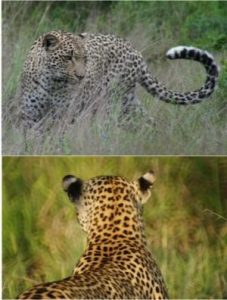
Figure 8. Leopard, showing the tail flag and back-of-ear flag [photos © T. Ellis under Creative Commons licence 2.0].
Colouration of the mouth and chest in large felids seems to vary according to their habitats and social habits. The tiger, for example, ventures into bright light but its lack of a mouth flag is consistent with its solitary disposition. As for the snow leopard: its habitat has patches of snow even in summer, making its pale chest ambivalent in terms of conspicuousness even when exposed in the sitting position. The paleness of its chest could theoretically function as a flag but the extremely sparse population of the snow leopard suggests not. The jaguar is, like the tiger, largely solitary. It stays under cover and lacks the gregariousness of the lion, so any flag would seem redundant in a species communicating intraspecifically mainly by scent marking.
Let’s now turn to the next flag in the felid inventory: the tail flag. No other species of felid shares the tail tassel of the lion, but leopard, cheetah and snow leopard have conspicuous tail flags (see Figures 6 and 7). These take the form of bold black bands, on a fluffy terminal part of the tail, contrasted against a pure white ventral surface. It seems significant that the jaguar and puma lack a tail flag despite their ecological similarity to the leopard. We encourage readers to offer explanations for this in the comment stream below.
Focusing now on the neck: the neck flag of the female lion is so subtle that we might be seeing things – were it not for the presence of more strikingly pale panels on various other carnivores, particularly hyenas. Most felids lack a neck flag, but the lion may be the exception that proves the rule because it’s the most gregarious species in a family of loners that usually have little opportunity to communicate visually. In the African hunting dog, which is the most hyena-like of canids, most markings on the body vary individually but the neck flag is remarkably consistent. And surprisingly, certain species of civet – solitary species resembling felids in their disruptive spots and stripes on body and tail – have an incongruous patch on each side of the neck. It is not clear how civets would benefit from this neck flag. Again, we encourage readers to put forward suggestions.
Although the function of a pale neck flag in all likelihood varies across the spectrum of carnivores, its presence in the female lion is a subtle counterpart to the dark mane of the male lion. We suggest that the neck flag aids conspicuousness to other lions as opposed to aiding crypsis when the lion is hiding from prey.
Moving on to ears: in all carnivores, the ears are less easily hidden than the mouth during a crouched stalk. This basic rule explains why, in general, the front of the ears has cryptic colouration, even in those felid species with conspicuous mouths. The lion epitomises this combination: the front of the ears is as uniformly brownish as in any large mammal with furry ears, but the mouth – which can be displayed to conspecifics once the stalk is abandoned and the head is raised – is whitish. Furthermore, the lion is the only species of cat combining a back-of-ear flag with a neck flag, the two flags combining to produce tonal contrast. Although most species of felids possess patterns on the back-of-ear, in most cases this consists of a pale mark punctuating an otherwise dark surface. In the case of the lion, the dark part of the back-of-ear has virtually displaced the pale part to a distal position, and the tonal contrast is instead with the side of the neck.
The felid species which deviates most from expectations in its inventory of flags is the puma. Despite resembling the lion in being plain-coloured and hunting partly in open vegetation, the puma has at best poorly developed flags on chest, tail, and back-of-ear, while instead having an extremely well developed mouth flag, framed by dark in a way seen in no other large cat (see Figure 9). The particular conspicuousness of its mouth seems to transcend intraspecific interactions, and is shared with several smaller felids such as caracal and pampas cat, suggesting a form of warning colouration that functions interspecifically (see our blog-post: A best-kept secret of wild cats: the aposematic bar code).

Figure 9. Puma compared with lion, showing the greater contrast between pale and dark facial features in the puma than in the lion [photos © T. Cheesman (left) and Tambako the Jaguar under Creative Commons licence 2.0 (right)].
We offer some additional interpretations of the back-of-ear flags. These flags are intriguingly inconsistent among species of large felids. For example, the pattern in the puma isn’t conspicuous enough to qualify as a back-of-ear flag. In the case of jaguar and snow leopard, the patterns are distinct but the whole ears of these species are so small that any conspicuousness is limited. By contrast, both sexes and all ages of the tiger have such a vivid white spot in the centre of a relatively large and otherwise black back-of-ear that there’s real shock value here. Indeed, the tiger certainly has a back-of-ear flag and may even exemplify that rare phenomenon: false eyespots in a mammal.

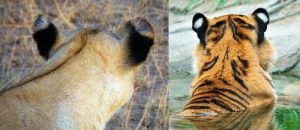
Figure 10. Lion compared with tiger, showing divergence of back-of-ear flags from a basic common pattern in the two species [photos © D. Bygott (left) and Tambako the Jaguar (right)].
Given that the back-of-ear pattern of the lion accentuates the dark bar whereas those of tiger, jaguar and snow leopard accent the pale spot (see Figure 10), it’s intriguing to see parallels in the leopard and cheetah, which naturally coexist with the lion in Africa and Asia. Like the lion, the leopard and cheetah raise the backs of the ears in what appears, at medium distance, like a rudimentary bar code, above the blur of the spotted napes of these two species of felids. Any convergence of back-of-ear flags among lion, leopard and cheetah is unlikely to be accidental because a similar banded pattern is absent from large felids elsewhere, and because the same three species also converge in their tail flags.
This similarity in back-of-ear and tail flags remains a mystery just beyond the Bio-edge. However, we speculate that, by exploiting a subtle form of mimicry of the most formidable of living felids, the leopard and cheetah protect themselves and their offspring from other carnivores such as the spotted hyena. Again, we challenge readers to test the possibility that this functions partly at night and partly in ultraviolet.
Perhaps our most thought-provoking observation is that the cheetah – despite being the least formidable of large felids – emulates the lion in four flags: mouth, chest, tail and back-of-ears (see Figure 6). The cheetah also has a mane, although this appears in juveniles of both sexes rather than the mature male. The obvious explanation to test is protective mimicry, something that has previously been mooted for the resemblance of the juvenile cheetah to the honey badger.
Although defensive mimicry may be tricky to test, we have raised another, more simple hypothesis ready to be pounced on by a suitably armed reader: that the flags of cats function partly in ultraviolet. Which reader has the equipment to test whether certain tracts of the fur of the lion – and possibly, by mimicry, the cheetah – reflect outside the spectrum visible to the human eye? A pilot study could be made on skins in museums or mounted heads on the walls of trophy rooms. The first patches to test for ultraviolet reflectance would be the whitish fur around the mouth, the silvery-fawn fur on the neck near the cheeks, and the silvery-fawn tip of the back-of-ear, all of which should be intact on most trophies. Please let us know of your findings in the comment stream below.… See the hidden half of this Biological Exposition by subscribing here
***
All text and images appearing in this blog are subject to copyright, except those images explicitly stated to be in the public domain. You are not free to use any photographs, for any purpose, without receiving written permission from the copyright holder.

